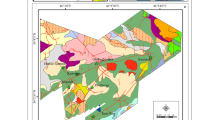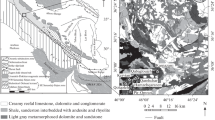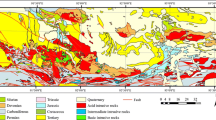Abstract
In this paper, we applied two kinds of knowledge-driven methods, one using the fuzzy logic and another using geometric average to evaluate 3D mineral prospectivity for Sansong district, Yongyu apatite deposit, in the Phyongnam Basin, DPR Korea. Based on the ore geology studies of apatite deposits and the available spatial datasets in the study area, we used four independent evidential maps for 3D apatite deposit prospectivity modeling. They include (1) carbonatite, (2) biotite gneiss, (3) granitic gneiss, and (4) P2O5 values from the borehole data. The evidential factors were modeled into 3D space, and 3D P2O5 values from the borehole data were transformed into continuous values of the [0, 1] range using logistic sigmoid. In 3D MPM just as 2D MPM, it is very economic and efficient to simultaneously apply the fuzzy logic and geometric average methods for mineral prospectivity modeling of the study area because two predictive models can use the same fuzzification methodology based on fuzzy membership function. Our strategy is to fuzzify the evidential maps before applying the geometric average as well as in the fuzzy logic. The results for the two predictive models were validated by the prediction efficiency method. The results demonstrated that most of the validation data were distributed in voxels with high prospectivity values. Although the validation results were slightly worse than those in 2D MPM case study, our case studies suggested that both predictive models and their modeling results are useful for evaluating 3D prospectivity of apatite deposits in Sansong district, Yongyu apatite deposit, DPR Korea.











Similar content being viewed by others
References
Behera S, Panigrahi MK (2021) Gold prospectivity map** in the Sonakhan Greenstone Belt, Central India: a knowledge-driven guide for target delineation in a region of low exploration maturity. Nat Resour Res 30:4009–4045
Chen YL, Wu W, Zhao QY (2020) A bat algorithm-based data-driven model for mineral prospectivity map**. Nat Resour Res 29:247–265
Cheng J (2021) Construction and visualization of a three-dimensional model of an engineering geological body. Arabian J Geosci. https://doi.org/10.1007/s12517-021-06600-x
Choe P, Ho D, Yun J, Sin Y, Jo S (2011) Encyclopedia of Korean Geology, Vol. 8. Industrial Publishing House, p 536
Coolbaugh MF, Raines GL, Zehner RE (2007) Assessment of exploration bias in data-driven predictive models and the estimation of undiscovered resources. Nat Resour Res 16:199–207
Deng H, Zheng Y, Chen J, Yu SY, ** using incomplete data at the scale of investigation. Nat Resour Res. https://doi.org/10.1007/s11053-015-9263-2
Geovia (2015) GEOVIA SurpacTM-geology and mine planning software. The 3D EXPERIENCE Company, Vancouver. http://www.geovia.com/products/Surpac
Hosseini SA, Abedi M (2015) Data envelopment analysis: a knowledge-driven method for mineral prospectivity map**. Comput Geosci 82:111–119
Ju JK (2020) The geological and economic geological characteristics of carbonatites in DPR Korea. PhD thesis. Kim Chaek University of Technology, p 231
Khosravi V, Shirazi A, Shirazy A, Hezarkhani A, Pour AB (2022) Hybrid fuzzy-analytic hierarchy process (Ahp) model for porphyry copper prospecting in Simorgh area, eastern Lut block of Iran. Mining 2:1–12
Kim YH, Choe KU, Ri RK (2019) Application of fuzzy logic and geometric average: a Cu sulfide deposits potential map** case study from Kapsan basin, DPR Korea. Ore Geol Rev 107:239–247
Kreuzer O, Miller A, Peters K et al (2015) Comparing prospectivity modelling results and past exploration data: a case study of porphyry Cu-Au mineral systems in the Macquarie Arc, Lachlan Fold Belt, New South Wales. Ore Geol Rev 71:516–544
Li RX, Wang GW, Carranza EJM (2016) GeoCube: a 3D mineral resources quantitative prediction and assessment system. Ore Geol Rev 89:161–173
Li TF, ** for tungsten polymetallic mineral resources, Nanling Metallogenic Belt, South China: use of random forest algorithm from a perspective of data imbalance. Nat Resour Res 29:203–227
Li H, Li XH, Yuan F, Jowitt SM, Dou FF, Zhang MM, Li XL, Li Y, Lan XY, Lu SM, Ding WX (2022) Knowledge-driven based three-dimensional prospectivity modeling of Fe-Cu skarn deposits; a case study of the Fanchang volcanic basin, anhui province, Eastern China. Ore Geol Rev. https://doi.org/10.1016/j.oregeorev.2022.105065
Lisitsin VA, Porwal A, McCuaig TC (2014) Probabilistic fuzzy logic modeling: quantifying uncertainty of mineral prospectivity models using Monte Carlo simulations. Math Geosci 46:747–769
Liu JT, Cheng QM (2019) A modified weights-of-evidence method for mineral potential prediction based on structural equation modeling. Nat Resour Res 28(3):1037–1053. https://doi.org/10.1007/s11053-018-9435-y
Mallet JL (2002) Geomodeling. Applied Geostatistics Oxford University Press, New York, pp 1–10
Mao XC, Ren J, Liu ZK, Chen J, Tang L, Deng H, Bayless RC, Yang B, Wang MJ, Liu CM (2019) Three-dimensional prospectivity modeling of the Jiaojia-type gold deposit, Jiaodong Peninsula, Eastern China: a case study of the Dayingezhuang deposit. J Geochem Explor 203:27–44
Micromine (2015) Micromine exploration & 3D mine design software. Micromine Pty Ltd., Perth. http://www.micromine.com/products-downloads/micromine. Accessed 25 Nov 2015
Mohammadpour M, Bahroudi A, Abedi M (2021) Three dimensional mineral prospectivity modeling by evidential belief functions, a case study from Kahang porphyry Cu deposit. J African Earth Sci. https://doi.org/10.1016/j.jafrearsci.2020.104098
Nykänen V, Lahti I, Niiranen T, Korhonen K (2015) Receiver operating characteristics (ROC) as validation tool for prospectivity models-amagmatic Ni-Cu case study from the Central Lapland Greenstone Belt, Northern Finland. Ore Geol Rev 71:853–860
Paek R, Kang H, Jon G, Kim Y, Kim Y (1993) Geology of Korea. Foreign Languages Books Publishing House, p 619
Perrouty S, Lindsay MD (2014) 3D modeling of the Ashanti Belt, southwest Ghana: evidence for a litho-stratigraphic control on gold occurrences within the Birimian Sefwi Group. Ore Geol Rev 63:252–264
Prado EMG, Roberto C, Carranza EJM, Motta JG (2020) Modeling of Cu-Au prospectivity in the Carajás mineral province (Brazil) through machine learning: dealing with imbalanced training data. Ore Geol Rev. https://doi.org/10.1016/j.oregeorev.2020.103611
Ren M, Chen J, Shao K, Zhang S (2016) Metallogenic information extraction and quantitative prediction process of sea floor massive sulfide resources in the Southwest Indian Ocean. Ore Geol Rev 76:108–121
Shabani A, Ziaii M, Monfared MS, Shirazy A, Shirazi A (2022) Multi-dimensional data fusion for mineral prospectivity map** (MPM) using fuzzy-AHP decision-making method, Kodegan-Basiran region, East Iran. Minerals. https://doi.org/10.3390/min12121629
Shirazi A, Hezarkhani A, Pour AB, Shirazy A, Hashim M (2022) Neuro-fuzzy-AHP (NFAHP) technique for copper exploration using advanced spaceborne thermal emission and reflection radiometer (ASTER) and geological datasets in the Sahlabad mining area, East Iran. Remote Sens. https://doi.org/10.3390/rs14215562
Shirazy A, Ziaii M, Hezarkhani A (2021) Geochemical behavior investigation based on K-means and artificial neural network prediction for titanium and zinc, Kivi region. Iran Bull Tomsk Polytech Univ 332:113–125
Tao JT, Yuan F, Zhang NN, Chang JY (2021) Three-dimensional prospectivity modeling of Honghai volcanogenic massive sulfide Cu-Zn deposit, Eastern Tianshan, Northwestern China using weights of evidence and fuzzy logic. Math Geosci 53:131–162
Wang Y, Chen JP, Jia DH (2020) Three-dimensional mineral potential map** for reducing multiplicity and uncertainty: Kaerqueka polymetallic deposit, QingHai province, China. Nat Resour Res 29:365–393
**: a case study of Jiama copper-polymetallic deposit in Tibet, China. Ore Geol Rev 71:357–367
**. Comput Geosci 111:18–25
Yousefi M, Carranza EJM (2015a) Fuzzification of continuous-value spatial evidence for mineral prospectivity map**. Comput Geosci 74:97–109
Yousefi M, Carranza EJM (2015b) Prediction-area (P-A) plot and C-A fractal analysis to classify and evaluate evidential maps for mineral prospectivity modeling. Comput Geosci 79:69–81
Yousefi M, Carranza EJM (2015c) Geometric average of spatial evidence data layers: a GIS-based multi-criteria decision-making approach to mineral prospectivity map**. Comput Geosci 83:72–79
Yuan F, Li X, Zhang M, Jowitt SM, Jia C, Zheng T, Zhou T (2014) Three-dimensional weights of evidence-based prospectivity modelling: a case study of the Baixiangshan mining area, Ningwu Basin, Middle and Lower Yangtze Metallogenic Belt, China. J Geochem Explor 145:82–97
Zadeh LA (1965) Fuzzy sets 8. Institute of Electric and Electronic Engineering, Information and Control, pp 338–353
Zhang H, **ao JY, Carranza EJM, Yang F (2019) Maximum entropy and random forest modeling of mineral potential: analysis of gold prospectivity in the Hezuo-Meiwu district, West Qinling Orogen, China. Nat Resour Res 28:645–664. https://doi.org/10.1007/s11053-018-9425-0
Zuo R, Zhang Z, Zhang D, Carranza EJM, Wang H (2015) Evaluation of uncertainty in mineral prospectivity map** due to missing evidence: a case study with skarn-type Fe deposits in Southwestern Fujian Province, China. Ore Geol Rev 71:502–515
Acknowledgements
The authors thank the geological survey of Yongyu mine for their contributions to provide geological data of Yongyu apatite deposit and their support during the field work. We also appreciate Prof. Abdullah M. Al-Amri, Editor-in-Chief; Prof. Biswajeet Pradhan, Chief Editor and Associate Editor; and three anonymous reviewers for their thorough reviews of the manuscript and their constructive comments which helped us to improve this paper.
Author information
Authors and Affiliations
Corresponding author
Ethics declarations
Conflict of interest
The authors declare no competing interests.
Additional information
Responsible Editor: Biswajeet Pradhan
Rights and permissions
Springer Nature or its licensor (e.g. a society or other partner) holds exclusive rights to this article under a publishing agreement with the author(s) or other rightsholder(s); author self-archiving of the accepted manuscript version of this article is solely governed by the terms of such publishing agreement and applicable law.
About this article
Cite this article
Kim, YH., Choe, KU. Three-dimensional prospectivity modeling based on fuzzy logic and geometric average: a case study from Sansong district, Yongyu apatite deposit, DPR Korea. Arab J Geosci 17, 117 (2024). https://doi.org/10.1007/s12517-024-11920-9
Received:
Accepted:
Published:
DOI: https://doi.org/10.1007/s12517-024-11920-9




